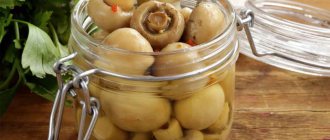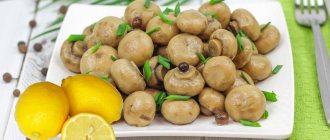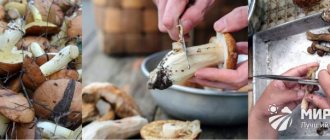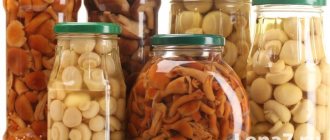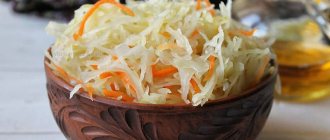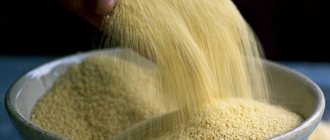Mushrooms
0
1412
Article rating
Kira Stoletova
In addition to harvesting a good harvest, the mushroom picker faces another task. Storing dried mushrooms is an equally important issue. High-quality and properly prepared fruiting bodies are suitable for this. If you follow certain rules, the products will not lose their original taste and aroma.
Storing dried mushrooms
Which edible mushrooms are suitable for long-term storage?
The point of drying is to remove moisture from the product as much as possible, which almost completely eliminates its spoilage during storage. The duration and effectiveness of drying depends on the structure, density and initial moisture content of the mushrooms. Not all edible mushrooms are suitable for this processing method.
Tubular mushrooms with an initial low humidity are ideal for drying:
- white (ideal appearance for this processing method, retains aroma, taste and attractive white color);
- boletus;
- boletus;
- honey fungus;
- meadow champignon;
- oiler;
- dubovik (moss fly).
Chanterelle is considered a conditionally suitable mushroom for drying, since the finished product may contain bitterness. It is recommended to pre-soak the chanterelles in cold water for about 2 days, only then proceed to drying.
Fragile mushrooms (umbrellas, russula) and conditionally edible mushrooms that require soaking to remove bitterness (milk mushrooms, valui, pig mushrooms, morels and stitches) are not dried.
How to prepare for drying
Freshly picked mushrooms are sorted. It is advisable that they be the same size and age, then they will dry evenly. Most species tolerate drying well, but there are some that are better not dried.
For example, this storage method is more suitable for those species that have tubular and marsupial structures:
- white,
- boletus,
- boletus mushrooms
Species with a lamellar structure are also dried:
- chanterelles,
- honey mushrooms,
- oyster mushrooms and mushrooms.
Although it should be noted that when dried they develop a bitter taste.
Preparation
Only clean, not previously washed, mushrooms without signs of worms are dried. Contaminants are removed from the surface with a dry cloth.
Since the density of the stem and cap is different, they are dried separately. Large caps and stems are cut into pieces of approximately equal thickness. The optimal size of the pieces is 4–6 cm.
Drying options:
- strung on a rope, in a warm room with good ventilation (the longest option is several days);
- in a household electric dryer at 50 degrees for 3–5 hours;
- in the oven with the door open, 2–3 hours;
- in a dehydrator.
A sign that a product is ready is its fragility.
Attention! Only store the product that has cooled to room temperature. Mushrooms that are hot after drying and placed in an airtight jar may become damp.
Drying methods
- You can dry it outdoors on warm sunny days; the procedure is carried out for about a week. To do this, all identical specimens are strung on a rope so that they do not touch each other, and hung in the sun, covering the top with gauze, this will protect the drying from dust or insects. The cut products must be placed on a tray covered with paper and placed in the sun, turning over periodically.
- You can dry the mushrooms in the oven; to do this, they are laid out on a metal grid; if there is none, then paper is placed on a baking sheet, and the food is placed on top. Initially, the temperature in the oven should be about 45 degrees, after the product becomes limp, increase it to 60 degrees. To ensure effective drying, open the door slightly.
- The cut pieces can be dried in the microwave; for this, the thickness of the plates should be up to 5 millimeters. They are laid out on a plate or wire rack, and the device is turned on for 5 minutes at a power of 100 W. Then you need to open the door, ventilate, and turn it on again for the same time, repeating the steps until completely dry.
- An electric dryer is the most convenient device for drying sliced \u200b\u200bplates or the whole product. The time and temperature are set on the device, and after complete drying the product is removed.
If properly dried, the product will have a long shelf life, will delight you with its pleasant fresh aroma in the winter, and is suitable for preparing soups and other various dishes.
How to store dried mushrooms at home
The main condition for proper storage is to place the dried product in a place where it cannot become damp. The maximum permissible air humidity is 50%, the optimal temperature in the storage is +10 +25 degrees. The product is also protected from exposure to light.
The storage location can be a closet in the kitchen, a dry pantry, or a dark corner in the room (under the bed). You should not put it in places where humidity and temperature often change: a corridor near the front door, a balcony.
Storage conditions
Many housewives, drying mushrooms on a rope, leave mushroom garlands hanging in the kitchen, making them an original element of the interior.
Of course, it looks beautiful, but during storage, dust, soot and grease settle on the food, and flies infest it. For proper storage, care should be taken to clean the product and protect the mushrooms by wrapping them in cloth.
Common packaging options for preserving dried mushrooms:
- fabric bag (it is better to use natural cotton or linen fabric of rare weave);
- paper bag;
- birch bark or wooden tub;
- cardboard box;
- a plastic or wooden box with lattice walls, lined with paper;
- dry glass jar with a tight-fitting lid;
- vacuum container or bag.
On a note. Mushrooms placed in a hermetically sealed container retain their flavor the longest.
We recommend:
How to store tulip bulbs at home
Before use, the container is thoroughly washed with soda or salt, scalded with boiling water and dried. Fabric bags and plastic lids are kept in a hot, strong saline solution.
You should not put the dry product in the refrigerator, as there is high humidity and low temperature. Mushrooms in such conditions instantly become damp and can spoil within a few days.
Shelf life
How long can dried mushrooms be stored? If the recommended constant temperature and humidity are observed, dry mushrooms retain their properties for at least 2 years.
Dried mushrooms stored in glass jars with tight lids last longer. Their shelf life reaches 4 years.
During storage, it is advisable to periodically inspect the product. If a cobweb appears in the mushrooms and some of the pieces turn into dust, food moths have appeared in the product. In this case, there is no time to waste; you need to urgently sort out the mushrooms and put them into culinary processing.
Important! If mold or a musty smell appears, the mushrooms should be thrown away. They are not suitable for consumption!
Useful cooking tips
Dried mushrooms are widely used in cooking for cooking soups, stewing, and making sauces. There are uniform rules for preparing the product for use:
- The required amount of dried mushrooms is placed in a bowl.
- Fill the semi-finished product with hot water (but not boiling water!) completely, to the top.
- Leave covered for 2 hours.
- The mushrooms, saturated with moisture and softened, are cut and sent for further processing. The soaking water is also used in cooking, as a base for broth or sauce.
Dried mushrooms can be used to make a flavorful seasoning. To do this, the product is crushed in a mortar or coffee grinder to fine crumbs without pre-soaking. You can add dried garlic and dill to the seasoning. The resulting powder can be added to sauces, mixtures for marinating meat, soups and salads, and broth for cooking potatoes and pasta, giving the dish a unique mushroom aroma and taste. The seasoning should be stored in a tightly closed jar in a dark place.
Proper procurement process is the key to success
The most important rule for collecting and storing mushrooms for future use is the following: the danger of harming health lurks not only in the mushrooms themselves, but also in the conditions of their collection. Even the most beloved and healthy boletus mushrooms, boletus mushrooms or boletus mushrooms can cause poisoning if they were not collected in environmentally friendly places.
The “body” of the mushroom, like a sponge, absorbs everything that surrounds it. And if, for example, any chemicals were used nearby, the fungus will accumulate them. And in dried form, the chemicals will also acquire a high degree of concentration.
The most economical way to dry mushrooms is simply under the sun.
Drying mushrooms is easy.
You just need to know which types are best suited for this method of long-term food storage. An excellent result can be obtained by preparing various types of tubular mushrooms in this way. If there is a good harvest of porcini mushrooms, boletus, boletus or aspen mushrooms, then the best way to preserve them for future use is drying.
Champignons are also suitable for this. Lamellar types of mushrooms have a bitter taste after drying. But this can be easily fixed by soaking them.
Raw materials collected in rainy weather will not be very successful for drying. In addition, some types of mushrooms (for example, russula) themselves are quite raw and contain a lot of moisture. Drying them is not recommended.
It is also important to correctly set the duration of the drying process. Poorly dried slices will not be stored for long; they will develop mold.
Very dry pieces crumble, are not very suitable for cooking, and become not so tasty. Their crust will be too hard. Properly dried mushrooms do not break, but bend when squeezed in your hand.
It is necessary to prepare mushrooms for drying in the following way: they are sorted, sorted, cut lengthwise in thin layers, without separating the stem from the cap. Water treatments are under no circumstances allowed.
Moisture will cause the porous flesh of the mushrooms to absorb water. There will be a good opportunity for rot to form. Already dry mushrooms are washed immediately before cooking.
It is very important to ensure access of fresh air to the workpiece during the drying process. But mushrooms must be protected from dust or moisture.
A good option would be to use an oven or stove. The prepared pieces are placed on a baking sheet and dried in an open oven. The temperature must be adjusted so that the moisture evaporates slowly.
Dried mushrooms retain their taste properties for a long time when stored in bags.
You can dry mushrooms simply under the sun. While drying, the slices must be turned regularly.
Before storing the product, you need to ensure the quality of drying. Damp pieces with soft caps will rot, mold, and become prey for worms or larvae.
Dried mushrooms should not be thrown away; they are used to prepare a seasoning that will improve the taste of many dishes.
This is mushroom powder. It's easy to prepare. Pieces that are too brittle need to be crushed in a coffee grinder, sifted through a sieve and mixed with salt, dried herbs, and bay leaves.
Spicy seasoning is stored in the same way as other spices: in glass jars with lids. You can use ground mushrooms without pre-soaking, adding them to almost finished dishes (five minutes before the end of cooking). You can store the powder from heavily dried mushrooms for up to a year, placing it in a dry, tightly closed glass jar.
